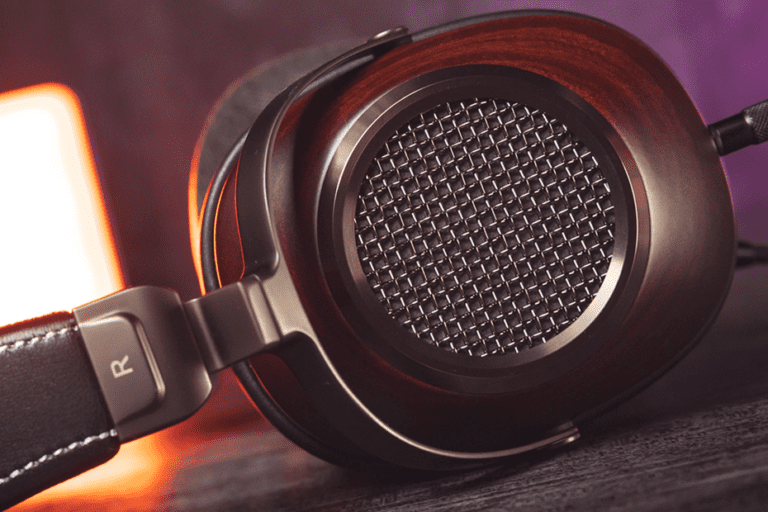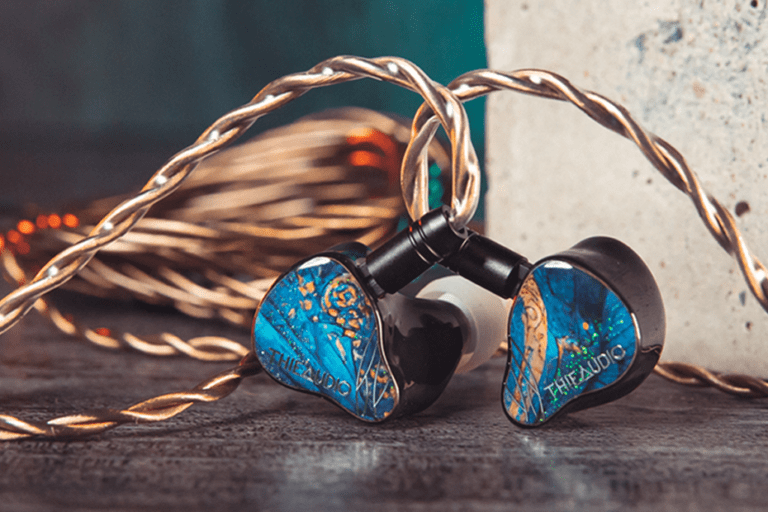Today we’re looking closely at Kiwi Ears Orchestra Lite in-ear monitors. I would like to thank Linsoul for providing the sample for this review. I am not paid to make this review or offer any specific opinions about this product. And all thoughts expressed in today’s episode are my own.
Kiwi Ears Orchestra Lite features an 8-balanced armature drivers per side, 3-way passive crossover, beautiful resin shells, and de-attachable 4-core cable. Kiwi Ears decided to redesign the original Orchestra to increase its performance and optimise the cost. This was achieved by using customized BA drivers that were developed for Kiwi Ears. As a result, we can now have an IEM with an 8 BA configuration that doesn’t break the bank.
But as usual, let’s start with the unboxing. Orchestra Lite arrived in a medium-sized beautiful carton box with a sleeve. On the front of the sleeve, there is a branding and illustration of the IEMs. On the back of the sleeve, there is company information. Brief specifications including the driver types can be found on the side of the sleeve. Inside the sleeve, there is a black box with a Kiwi Ears logo in silver.
In the box:
- Kiwi Ears Orchestra Lite IEMs
- A detachable 0.78mm 2-pin cable
- 9 pairs of silicone ear tips
- A carrying case
- and a manual.
The impedance of IEM is 18Ω, sensitivity is 112 dB. Orchestra Lite is available in five different color schemes – green, blue, purple, orange, and clear (which stands for transparent). My sample is an orange one, but I’d call it amber. Besides excellent tuning, it’s obvious that Kiwi Ears doesn’t forget about visual aesthetics. And it’s good to see that Orchestra Lite also follows this trend.
Design & build
The shells are made out of medical-grade resin and the amber color pattern looks mesmerizing. The shells are glossy, but surprisingly they don’t catch the fingerprints easily. Both faceplates carry the Kiwi Ears logo. The nozzles are on the longer side, are quite thick, and have three sound bores. The nozzle diameter is 6mm, and there is no mesh or filter at the end of the nozzle. This means you need to be careful and make sure you clean your ear tips regularly. There is no usual lip that helps with ear tip retainment, but the nozzles are wider at the end and it helps to secure it.
Inside the shell we have an 8-driver configuration with a passive crossover. 2 Knowles BA for bass, 4 customized Kiwi Ears BAs for midrange, and 2 customized Kiwi Ears BAs for the treble. Due to the transparent shell design, you can clearly see the driver configuration. The 2-pin connector is conveniently placed on top of the IEM. And surprisingly there are no vent holes at all. Taking into consideration 8 drivers per side the IEMs are hefty and I liked it a lot. Visually they are also beautiful and I really enjoyed this particular orange color scheme.
Cable
The cable that comes with this IEM is very good. It’s 1.2 meters long and has a straight 3.5 mm connector on one end and two 0.78mm 2-pin connectors on the other end.
The cable connectors have no usual letter channel indication, however the base on the right connector is red, so this helps with the channel navigation a bit. Still, I prefer the connectors to have channel markings on the side too for more convenient channel navigation.
The cable has a metal splitter, soft pre-molded ear guides, and a plastic chin slider. Overall, I think this cable is pretty good. It’s soft and is low in microphonics, The pre-molded ear guides are soft too, and it helps to achieve a relaxed fit with this IEM.
Fit & comfort
The Kiwi Ears Orchestra Lite shells are well-polished and there are no sharp edges here. The shells are large and hefty but have a very natural and ergonomic shape. In my case, the fit was very good, but if you have small ears, you may struggle with a fit.
I also had no issues with the stock ear tips, and I was able to reach a good fit & seal instantly which is a huge plus for me. But I need to point out that the quality of the stock ear tips is lacking, and as someone already mentioned, I’d rather have 1 set of quality silicone ear tips than 3 included sets of mediocre tips.
Still, I’ve been using Orchestra Lite for extended periods and as the fit was fantastic in my case, I never experienced any discomfort. In terms of passive noise isolation, the Orchestra Lite also performs well. It effectively blocks out most outside noise, allowing you to fully immerse yourself in your music without the need to turn the volume too high. But as it has no vents, some people may experience fatigue.
Kiwi Ears Orchestra Lite sound overview
Now let’s talk about the sound. Please note that all sound impressions that I am sharing on this channel are completely subjective so please take them with a grain of salt.
At 18 Ohms of impedance and 112 dB of sensitivity, Kiwi Ears Orchestra Lite is easy to drive, and I had no issues driving it from my Samsung Galaxy S10. It also won’t benefit much from a more powerful source, but using it with a more quality source can have a positive impact on the sound too.
The Orchestra Lite offers a very interesting listening experience, especially if you are into classical, jazz, and vocal music. The tuning is quite mid-centric, with a lightly pronounced bass and rounded treble, which sometimes reminded me of my Sennheiser HD 6XX. But unlike the 6XX, the overall presentation is a bit dry.
This is a full BA set, and when we talk about low frequencies, I wasn’t expecting sub-bass rumble and very punchy mid-bass. So in this regard, the IEM fully met my expectations. Two balanced armature drivers responsible for low frequencies are from Knowles and are tuned well, and while the bass is not near any dynamic driver bass levels, it still has some punch.
The bass notes are defined well with distinct hits, but the bass presentation is a bit soft and it lacks weight and body. This type of bass will be appealing to those familiar with analytical sound signatures, with gentle bass. The bass here also won’t please bass-heads and those who prefer some additional punch in the low end, but I still think Kiwi Ears did a good job with the choice of BAs and their tuning.
Enjoying this review? Read more In-Ear Monitor reviews here
The midrange of Kiwi Ears Orchestra Lite is probably the best part of its tuning. It’s coherent, linear, moved forward, and detailed. There is some bass bleed into the mids, which contributes to some additional warmth of the lower mids, which results in a full-bodied midrange presentation that sounds engaging. Vocals and instruments are quite upfront, with a good note weight, definition, and character. Neither lower nor upper mids sound thin, the timbre is great, and there are a lot of details in this part of the frequency range.
Orchestra Lite truly shines in its reproduction of instruments and vocals, as the mids are clean and detailed. This is especially appreciated when listening to acoustic tracks or vocal-centric genres. The midrange perfectly sits in the mix, and on many vocal tracks, I had the feeling the artist was right in front of me.
The treble extension of Orchestra Lite is good and coherent, though it’s a bit rounded. While it’s not the most detailed and airy treble I came across in IEMs, it still brings a good amount of energy to the table, and it was never harsh, intrusive, or grainy. no matter what music I was throwing at this IEM.
The details and micro details, while not class-leading, still provide a lot of information. However, if you seek a very open, airy, and analytical treble, you may be a bit disappointed. The treble on Orchestra Lite was particularly enjoyable when listening to well-mastered recordings with a good dynamic range, and with such music, the percussion, cymbals, and synths shine with life.
The sound stage is wide, but it’s not too deep. The height of the sound stage is average as well. And Orchestra Lite’s sonic landscape still feels a bit congested and compressed.
I enjoyed Kiwi Ears Orchestra Lite while listening to my music and also tried playing games with it, but the gaming performance was not very good, especially in the multiplayer games. I think this is due to the dry and mid-centric presentation, and the gaming landscape sometimes felt a bit unrealistic, lacking a sense of distance and accuracy. So unfortunately I can’t recommend this one for gaming.
At the same time, the separation of instruments is one of the best in this price bracket, and while the overall presentation is still a bit congested, the IEM never failed to bring all the necessary details in my music to light.
Conclusions
The Kiwi Ears Orchestra Lite was released at a very difficult price bracket. On one side, there are a lot of very good-sounding IEMs under $200, on the other side, the over $300 dollar range is dominated by well-known models for years. Orchestra Lite sits somewhere in between and is in a league of its own. From the moment I unboxed it and did my initial tests, I already knew it was a very special IEM. At the time of making this review, I already put more than 100 hours into them and my initial feelings about it didn’t change at all, though it still took me some time to finalize my impressions on this one.
What I liked
- Beautiful design and solid build
- Mid-centric turning with good details and energy
- Rounded treble extension
- Excellent instrument separation
- Great technical abilities for the price
- Excellent stock cable
- Studio-grade dry character
- and great price-to-performance ratio
What I didn’t like
- The bass lacks authority, rumble, and weight
- The stock ear tips are mediocre
- and I was expecting to see a better IEM case at this price point
Still, there are several reasons that easily justify the purchase of Kiwi Ears Orchestra Lite. First, if you want a full BA set. That said, Orchestra Lite is very competitive with its 8 drivers per side. Second, you want a mid-centric tuning and you don’t care too much about sub-bass rumble and crystal clear highs. The third aspect is that you are looking for an IEM with a dry studio character and excellent instrument separation. In this regard, Orchestra Lite checks all the boxes and I cannot think of a better IEM for the above-mentioned reasons, especially at the current price.
And that concludes my review for today. If you want to see more content like this consider subscribing to my YouTube channel for future updates. Thank you for joining me, and until next time, goodbye!
** As an Amazon Associate I earn from qualifying purchases. Some of the links in my reviews are affiliate links, which means at no extra cost to you, I will make a small commission if you click them and make a qualifying purchase.



